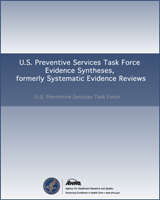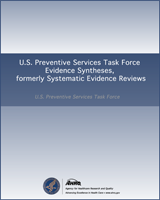NCBI Bookshelf. A service of the National Library of Medicine, National Institutes of Health.
This publication is provided for historical reference only and the information may be out of date.
Structured Abstract
Context:
Lipid disorders are an important risk factor for coronary heart disease (CHD). Screening and treatment of lipid disorders in persons at high risk for future CHD events have gained wide acceptance, especially for patients with known CHD, but the proper role in persons with low to medium risk is controversial.
Objective:
To examine the evidence about the benefits and harms of screening and treatment of lipid disorders in adults, adolescents, and children for the US Preventive Services Task Force.
Data Sources:
We identified English-language articles on drug therapy, diet and exercise therapy, and screening for lipid disorders from comprehensive searches of the MEDLINE database from January1994 through July 1999. We used published systematic reviews, hand searching of relevant articles, the second Guide to Clinical Preventive Services, and extensive peer review to identify important older articles and ensure completeness.
Study Selection:
We included all randomized trials of at least 1 year's duration that examined drug or diet therapy among patients without previously known CHD and that measured clinical endpoints, including total mortality, CHD mortality, or nonfatal myocardial infarctions. We also included randomized trials of diet or exercise therapy that measured change only in total cholesterol. To examine the question of screening, we included articles that addressed the epidemiology and natural history of lipid levels and lipid disorders or that measured the accuracy, reliability, acceptability, and feasibility of screening. We also included any articles that examined adverse effects and harms of screening or therapy for lipid disorders.
Data Extraction:
We extracted the following data from the included articles: demographic details about subjects; inclusion and exclusion criteria; and study design, duration, interventions, and outcome measures. We evaluated the internal and external validity of each article and judged the overall quality of evidence by examining aggregate internal and external validity and coherence of the results.
Data Synthesis:
There is strong, direct evidence that drug therapy reduces CHD events and CHD mortality in middle-aged men (35 to 70 years of age) with abnormal lipids and a potential risk of CHD events greater than 1%per year. Drug therapy may also reduce total mortality in patients at higher risk (greater than 1.5% per year). Less direct evidence suggests that drug therapy is also effective in other adults, including older men (over the age of 70 years) and middle-aged and older women (ages 45 years and older) with similar levels of risk. Trials of diet therapy for primary prevention have led to long-term reductions in cholesterol of 3% to 6%but have not demonstrated a reduction in CHD events overall. Exercise programs that maintain or reduce body weight can produce short-term reductions in total cholesterol of 3% to 6% but longer-term results in unselected populations have found small reductions or no effect.
Screening middle-aged and older men and women for lipid disorders can accurately identify persons at increased CHD risk who may benefit from therapy. The evidence is insufficient about benefits and harms of screening and treating persons at low absolute risk, including most men under 35 years of age, women under 45 years, and children and adolescents. To identify accurately persons with abnormal lipids, at least 2 measurements of total cholesterol and high-density lipoprotein cholesterol (HDL) are required. The role of measuring triglycerides and the optimal screening interval are unclear from the available evidence.
Conclusion:
Strong evidence shows the effectiveness of therapy for lipid disorders in middle-aged men; indirect evidence shows effectiveness in older men and women of sufficient risk. Screening for lipid disorders with total cholesterol and HDL and performing a global assessment of CHD risk can accurately identify those at sufficient risk who can benefit from treatment.
Key Word: Cardiovascular diseases - cholesterol - hyperlipidemia - preventive health services - evidence-based medicine - MEDLINE - methods - lipids - mass screening - mortality - drug therapy
Contents
Prepared for: Agency for Healthcare Research and Quality, U.S. Department of Health and Human Services.1 Contract No. 290-97-0011, Task Order No. 3, Technical Support of the U.S. Preventive Services Task Force. Prepared by: Research Triangle Institute University of North Carolina Evidence-based Practice Center.
Suggested citation:
Pignone MP, Phillips CJ, Lannon CM, et al. Screening for Lipid Disorders, Systematic Evidence Review No.4 (Prepared by the Research Triangle Institute -- University or North Caroline Evidence-based Practice Center, under contract No. 290-98-0011). AHRQ Publication No. AHRQ 01-S004. Rockville, MD: April 2001.
On December 6, 1999, under Public Law 106-129, the Agency for Health Care Policy Research (AHCPR) was reauthorized and renamed the Agency for Healthcare Research and Quality(AHRQ). The law authorizes AHRQ to continue its research on the cost, quality, and outcomes of health care, and expands its role to improve patient safety and address medical errors. This report may be used, in whole or in part, as the basis for development of clinical practice guidelines and other quality enhancement tools, or a basis for reimbursement and coverage policies. AHRQ or U.S. Department of Health and Human Services endorsement of such derivative products may not be stated or implied.
The authors of this report are responsible for its content. Statements in the report should not be construed as endorsement by the Agency for Healthcare Research and Quality or the U.S. Department of Health and Human Services of a particular drug, device, test, treatment, or other clinical service.
- 1
2101 East Jefferson Street, Rockville, MD 20852. www
.ahrq.gov
- Screening and treating adults for lipid disorders.[Am J Prev Med. 2001]Screening and treating adults for lipid disorders.Pignone MP, Phillips CJ, Atkins D, Teutsch SM, Mulrow CD, Lohr KN. Am J Prev Med. 2001 Apr; 20(3 Suppl):77-89.
- Review Lipid Screening in Childhood and Adolescence for Detection of Familial Hypercholesterolemia: A Systematic Evidence Review for the U.S. Preventive Services Task Force[ 2016]Review Lipid Screening in Childhood and Adolescence for Detection of Familial Hypercholesterolemia: A Systematic Evidence Review for the U.S. Preventive Services Task ForceLozano P, Henrikson NB, Dunn J, Morrison CC, Nguyen M, Blasi PR, Anderson ML, Whitlock E. 2016 Aug
- Review Lipid Screening in Childhood for Detection of Multifactorial Dyslipidemia: A Systematic Evidence Review for the U.S. Preventive Services Task Force[ 2016]Review Lipid Screening in Childhood for Detection of Multifactorial Dyslipidemia: A Systematic Evidence Review for the U.S. Preventive Services Task ForceLozano P, Henrikson NB, Morrison CC, Dunn J, Nguyen M, Blasi P, Whitlock EP. 2016 Aug
- Review Screening for Lipid Disorders in Children and Adolescents[ 2007]Review Screening for Lipid Disorders in Children and AdolescentsHaney EM, Huffman LH, Bougatsos C, Freeman M, Fu R, Steiner RD, Helfand M, Nelson HD. 2007 Jul
- Review Behavioral Counseling to Promote a Healthy Lifestyle for Cardiovascular Disease Prevention in Persons With Cardiovascular Risk Factors: An Updated Systematic Evidence Review for the U.S. Preventive Services Task Force[ 2014]Review Behavioral Counseling to Promote a Healthy Lifestyle for Cardiovascular Disease Prevention in Persons With Cardiovascular Risk Factors: An Updated Systematic Evidence Review for the U.S. Preventive Services Task ForceLin JS, O'Connor EA, Evans CV, Senger CA, Rowland MG, Groom HC. 2014 Aug
- Screening for Lipid DisordersScreening for Lipid Disorders
Your browsing activity is empty.
Activity recording is turned off.
See more...

